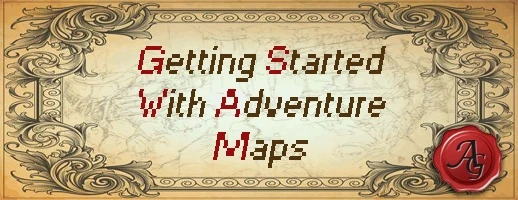This guide is made by The Adventurer's Guild - link to its official page here. I've just copied it here and I don't take any credits.
This mode will give the player a chance to "act out" a map made by it's creator. Just like reading a book, you can immerse yourself in this imaginary world and go through the hardships the player will encounter. But what exactly is an adventure?
ad·ven·ture
- an exciting or very unusual experience.
- participation in exciting undertakings or enterprises: the spirit of adventure.
- a bold, usually risky undertaking; hazardous action of uncertain outcome.
Here we go, suddenly an understanding of the word itself shines down a bright light on what to do with it. So let's get going!
How to get started?
Like most undertakings, careful planning is half the work done. To do it most efficiently, many people on the internet have templates written down to help future writers in making a good story. Basically, most of them can be cut down to this:
Step One: Theme
The theme is basically a one-sentence description of what your story is about. It's not the plot, or story line, or the short story, but the meaning behind it. Possible themes for short stories include: a quest for an item, escaping a prison, or surviving in the desert.
Step Two: Setting
The setting of your short story answers the questions where, and when. In a short story, where less detail is required, this can be pretty general. Possible settings include: Paris in 1890, a suburban neighborhood in 1980, or a dark damp cave in the middle of the jungle.
Step Three: Conflict
Conflict is the guts of any short story. You have to make your character have some sort of problem. Without conflict, there is no dramatic tension, and your short story ends up being boring. Possible conflicts could be: attacked by a pack of wolves, surrounded by fire, or something as innocuous as being lost.
Step Four: More Conflict
After you introduce the conflict, people don't want it to be solved right away. You should make your adventure map even more exciting by adding conflict atop more conflict. So, John Doe was attacked by a pack of wolves. Well, what if 5 seconds later the cave collapses and the character needs to escape?
Step Five: The Change
To bring an end to all this conflict in your adventure map, something must change. This is a great place for story development. A change in theme or personal goals perhaps? What would be at first a quest for diamonds is suddenly a quest for ultimate survival.
Step Six: The Resolution
Before you can end your adventure map, things need to be tied up. The theme from the first step needs to become clear and every step up to this point must climax to this part. All the hardships done must give the player a sense of satisfaction, one way or another. This makes a good adventure map great.
Using this seven-step plan for adventure map creation, will make your story writing easier. You will not have to struggle any more with putting too much, or too little, in your adventure background. And remember, using a formula is not somehow lacking in creativity. It is what you come up with to put in the formula that counts.
Other Useful Tips
- Learn to keep working on your stories.
- Remember, reading books will help to give you ideas - but you can't copy the ideas exactly.
- Write about something that you're interested in. It's much easier to write a story about things you enjoy.
- Listening to music can help you write effectively too. Listen to a song that fits your theme (if it's a horror story, listen to dark and scary music for example.)
- Find inspiration (family, friends etc.)
- Write a checklist of things to include in the story.
Good luck making your adventure map!
Regards,
- The Adventurer's Guild


